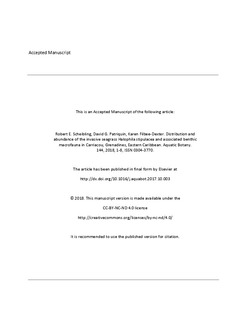| dc.contributor.author | Scheibling, Robert E. | |
| dc.contributor.author | Patriquin, David G | |
| dc.contributor.author | Filbee-Dexter, Karen | |
| dc.date.accessioned | 2019-09-20T13:39:14Z | |
| dc.date.available | 2019-09-20T13:39:14Z | |
| dc.date.created | 2018-03-19T10:56:33Z | |
| dc.date.issued | 2018 | |
| dc.identifier.citation | Aquatic Botany. 2018, 144, 1-8. | nb_NO |
| dc.identifier.issn | 0304-3770 | |
| dc.identifier.uri | http://hdl.handle.net/11250/2618067 | |
| dc.description | Embargo until 12 Oct 2019. | nb_NO |
| dc.description.abstract | The invasive seagrass Halophila stipulacea has spread throughout the eastern Caribbean since it was first recorded in Grenada in 2002. We quantified the distribution and abundance of H. stipulacea, and its associated macroinvertebrate fauna, in sampling stations and transects around the island of Carriacou (a nearby dependency of Grenada) in early 2016. Halophila stipulacea occurred in extensive monospecific stands (average bottom cover, 62%), or smaller mixed stands with native seagrass (Thalassia testudinum, Syringodium filiforme, Halodule wrightii), at 1–5 m depth in large bays along the leeward (west) coast. It was sparsely distributed on the more wave-exposed east and south coasts, usually in mixed patches with native seagrass. In leeward bays, H. stipulacea has largely replaced the native seagrass H. wrightii, providing a novel biogenic habitat for various filter-feeding invertebrates living within the turf-like leaf canopy (e.g., sponges, ascidians, bivalves, ophiuroids), and sea urchins (mainly Tripneustes ventricousus) and a microphagous sea star (Oreaster reticulatus) that graze upon it. Populations of the sea star consisted mainly of juveniles indicating the seagrass may serve as a nursery habitat for this endangered species. The spread of H. stipulacea along the leeward coast of Carriacou in recent years represents a community-level shift in the shallow subtidal zone, with attendant changes in habitat structure, species composition, and trophic interactions. | nb_NO |
| dc.language.iso | eng | nb_NO |
| dc.publisher | Elsevier | nb_NO |
| dc.rights | Attribution-NonCommercial-NoDerivatives 4.0 Internasjonal | * |
| dc.rights.uri | http://creativecommons.org/licenses/by-nc-nd/4.0/deed.no | * |
| dc.title | Distribution and abundance of the invasive seagrass Halophila stipulacea and associated benthic macrofauna in Carriacou, Grenadines, Eastern Caribbean | nb_NO |
| dc.type | Journal article | nb_NO |
| dc.type | Peer reviewed | nb_NO |
| dc.description.version | acceptedVersion | nb_NO |
| dc.source.pagenumber | 1-8 | nb_NO |
| dc.source.volume | 144 | nb_NO |
| dc.source.journal | Aquatic Botany | nb_NO |
| dc.identifier.doi | 10.1016/j.aquabot.2017.10.003 | |
| dc.identifier.cristin | 1573873 | |
| dc.relation.project | Andre: Natural Sciences and Engineering Research Council of Canada | nb_NO |
| cristin.unitcode | 7464,20,11,0 | |
| cristin.unitname | Marin biologi | |
| cristin.ispublished | true | |
| cristin.fulltext | original | |
| cristin.fulltext | postprint | |
| cristin.qualitycode | 1 | |

